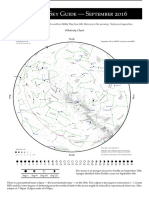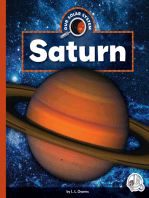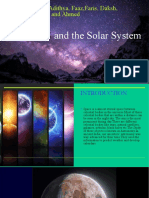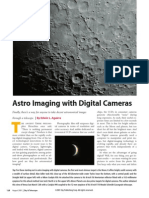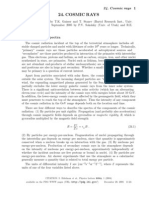Uranus, Neptune, and Pluto This Year
Uranus, Neptune, and Pluto This Year
Uploaded by
birbiburbiCopyright:
Available Formats
Uranus, Neptune, and Pluto This Year
Uranus, Neptune, and Pluto This Year
Uploaded by
birbiburbiOriginal Description:
Original Title
Copyright
Available Formats
Share this document
Did you find this document useful?
Is this content inappropriate?
Copyright:
Available Formats
Uranus, Neptune, and Pluto This Year
Uranus, Neptune, and Pluto This Year
Uploaded by
birbiburbiCopyright:
Available Formats
celestial calendar
AQUILA
M72
M73
1
1
AQUARIUS
13
15
CAPRICORNUS
61
May 1
21 Apr 1
Jun 1
Jul 1
20
SAGITTARIUS
Uranus
19
Dec 1
Nov 1
Neptune
Aug 1
Sep
Oct
1
1
Jun
1 Jul
1
May
1 Apr
1
Aug
1 Sep
1 Oct
1
Dec
1 Nov
1
20
17
4
h
21 00
20h45m
20 30
M75
20h15m
20h00m
Uranus, Neptune, and Pluto This Year
he eight major planets of the
solar system (aside from Earth)
span a range in brightness of about
30 million; Venus this year gets 18.6 magnitudes brighter than Pluto. Their size
differences, by comparison, are much
smaller. Venus is only 5 times as large as
little Pluto, and
By Alan M. MacRobert
even giant Jupiter
has just 60 times Plutos diameter. The
planets enormous range in brightness is
mostly due to their different distances
from the Sun (which determine how
brightly they are lit) and from Earth (affecting how big they appear to us).
Nevertheless, all the planets but one
can be spotted without a telescope.
Mercury, Venus, Mars, Jupiter, and Saturn are the five classical naked-eye
worlds. You can add Uranus to your list
pretty easily using binoculars. Its about
magnitude 5.7, technically making it a
naked-eye object under good sky conditions. Neptune is a somewhat tougher
binocular trophy at magnitude 7.9. Pluto,
magnitude 13.7, generally requires at
least an 8- or 10-inch telescope used at
high power with an extremely deep chart.
The charts here show where to locate
the three outermost planets on any date
for the rest of this years observing season.
Uranus and Neptune are in Capricornus about 10 apart. In April and May
they can be found fairly low in the southeast just before the first light of dawn. By
the beginning of summer theyre in this
part of the sky around midnight. They
Ophiuchus; its a degree or two south of
the 4.6-magnitude star Upsilon () Ophiuchi. (During late summer it edges over
the border into Scorpius.) Pluto is currently high in the south in the early
morning hours, approaching its May
27th opposition. It will be an evening
object in late spring, summer, and early
autumn.
Because Pluto looks just like millions
of similarly faint stars, identifying it is an
exercise in precision map work at the
telescope. The map on the facing page,
drawn largely from the
Join the nine-planet club by tracking down Hubble Guide Star Catalog, shows stars as faint as
the three farthest worlds of our solar system. blue magnitude 14 or 15,
somewhat dimmer than
come to opposition in early August and Pluto. However, many faint stars near this
late July, respectively. Their most conve- limit are missing from the Guide Star
nient observing season is late summer Catalog, and its magnitudes are not very
through early fall, when theyll be high in reliable. To be sure youve got Pluto,
the south in early evening.
check back on another night to see that
Pluto spends most of 1998 in southern your suspect has moved.
Uranus and Neptune spend 1998 shifting back and forth in Capricornus. Stars are plotted to magnitude 7.2 except near Neptune, where the
limit is 9.0. Ticks show the position of each planet at the beginning of every month.
96
May 1998 Sky & Telescope
1998 Sky Publishing Corp. All rights reserved.
Pluto drifts among faint stars near the OphiuchusScorpius border this year. Extremely dim at magnitude 13.7, it is still nearly a magnitude brighter
than the very faintest stars plotted here. North is
up, and east is left. The circled stars are 8th magnitude or brighter and appear on Wil Tirions Sky
Atlas 2000.0. Dates are at 0h Universal Time.
May 1
11
OPHIUCHUS
SCORPIUS
Jun 1
21
11
21
Jul 1
11
21
Aug 1
21
11
11
21
Pluto in 1998
Apr
1
Sep 1
11
21
Oct 1
11
21
Star magnitudes
5
16h32m
10
10 11 12 13 14
16h28m
16h24m
Advertisement
Sky & Telescope May 1998
97
You might also like
- PHY 103: Basic Principle of Physics II: Heat and ThermodynamicsDocument32 pagesPHY 103: Basic Principle of Physics II: Heat and ThermodynamicsLawal HakeemNo ratings yet
- A New Weapon in The War Against Radio Interference: October 1998Document1 pageA New Weapon in The War Against Radio Interference: October 1998birbiburbi100% (1)
- Data Sheet For WTPDocument27 pagesData Sheet For WTPrajayu20002724No ratings yet
- Applied Thermondynamic To Oil and Gas ProcessingDocument36 pagesApplied Thermondynamic To Oil and Gas ProcessingGuy Effa100% (3)
- Finding Uranus, Neptune, and PlutoDocument1 pageFinding Uranus, Neptune, and PlutobirbiburbiNo ratings yet
- Astronomy Wise August EZineDocument56 pagesAstronomy Wise August EZineDavid Bood100% (1)
- Skymaps Com 2015 03Document2 pagesSkymaps Com 2015 033582No ratings yet
- M T W TH F S S M T TH F S M T W TH F S S M TWTHF S S M T W: The Sun, Moon, and Planets in DecemberDocument2 pagesM T W TH F S S M T TH F S M T W TH F S S M TWTHF S S M T W: The Sun, Moon, and Planets in DecemberbirbiburbiNo ratings yet
- Astronomy Guide 2021-2022 by TelescopeGuideDocument12 pagesAstronomy Guide 2021-2022 by TelescopeGuideMichael Zhang0% (1)
- NASTRO Sky Guide - September 2016: Wholesky ChartDocument2 pagesNASTRO Sky Guide - September 2016: Wholesky ChartDr Adrian JannettaNo ratings yet
- Astronomy For Kids: Planets, Stars and Constellations - Intergalactic Kids Book EditionFrom EverandAstronomy For Kids: Planets, Stars and Constellations - Intergalactic Kids Book EditionNo ratings yet
- Skymaps Com 2014 04Document2 pagesSkymaps Com 2014 043582No ratings yet
- Space Solar Eclipse 2011 AaDocument7 pagesSpace Solar Eclipse 2011 AaGerardo LagunesNo ratings yet
- Information of SaturnDocument3 pagesInformation of SaturnSandeep SinghNo ratings yet
- Eclps 99Document6 pagesEclps 99Polaris93No ratings yet
- 2nd Pre Physical Science ReviewerDocument5 pages2nd Pre Physical Science ReviewerRowell PantilaNo ratings yet
- Taurus Leads A Starry Stampede: Stars & PlanetsDocument4 pagesTaurus Leads A Starry Stampede: Stars & PlanetsbirbiburbiNo ratings yet
- Sky MapsDocument2 pagesSky MapsPatrick SchwartzNo ratings yet
- Skypub MagazineDocument3 pagesSkypub MagazineKatNo ratings yet
- Planatery ParadeDocument15 pagesPlanatery ParadeUday DokrasNo ratings yet
- Assignement NavDocument2 pagesAssignement NavMohamed Omar IbrahimNo ratings yet
- Moonwalk 3.2Document1 pageMoonwalk 3.2eshachoukseNo ratings yet
- FST01 Unit 11 To 20Document152 pagesFST01 Unit 11 To 20sumit prajapatiNo ratings yet
- The Evening Sky Map: JANUARY 2014Document2 pagesThe Evening Sky Map: JANUARY 20143582No ratings yet
- NCERT 6th STD GeographyDocument68 pagesNCERT 6th STD GeographyPhaniDeepNo ratings yet
- Astronomical Events 2012Document19 pagesAstronomical Events 2012karlivan111No ratings yet
- July 2014 Night Skies Over TanzaniaDocument3 pagesJuly 2014 Night Skies Over TanzaniaOthman MichuziNo ratings yet
- What Is The ZodiacDocument5 pagesWhat Is The Zodiacaunghtoo1No ratings yet
- Stars and The Solar SystemDocument36 pagesStars and The Solar SystemR MithunNo ratings yet
- Solar System: Explanation By:-Sohan RDocument27 pagesSolar System: Explanation By:-Sohan RSohan TriceyNo ratings yet
- GuideDocument4 pagesGuidereoverosjonathan1No ratings yet
- Astronomy Calendar of Celestial EventsDocument42 pagesAstronomy Calendar of Celestial EventsClaud RichmondNo ratings yet
- CH 17 - Stars - and - The - Solar - System OutdatedDocument24 pagesCH 17 - Stars - and - The - Solar - System OutdatedHarshal BhagwatNo ratings yet
- Skymaps Com 2014 08Document2 pagesSkymaps Com 2014 083582No ratings yet
- Moons and PlanetsDocument46 pagesMoons and PlanetsCearra Mae EbronaNo ratings yet
- Starry Trails June 2015Document2 pagesStarry Trails June 2015shindudevilNo ratings yet
- 6th Social-Geography - The Earth Our Tablet PDFDocument67 pages6th Social-Geography - The Earth Our Tablet PDFNgaonii Panii PouNo ratings yet
- Almanak Astronomi 2015: Quadrantids Meteor ShowerDocument6 pagesAlmanak Astronomi 2015: Quadrantids Meteor ShowerFungki Andi SatriaNo ratings yet
- Planet ViewingDocument7 pagesPlanet ViewingMay'n SnNo ratings yet
- Introduction To AstronomyDocument3 pagesIntroduction To AstronomyGargee pNo ratings yet
- Jupiter's Eventful ReturnDocument1 pageJupiter's Eventful ReturnbirbiburbiNo ratings yet
- Uranus & Neptune-1Document36 pagesUranus & Neptune-1Shailendra Pratap 3767No ratings yet
- The Monthly Sky Guide PDFDocument66 pagesThe Monthly Sky Guide PDFMihai Acheson-DumbravaNo ratings yet
- Tugas DzakiDocument3 pagesTugas DzakiAndi Gentur MNo ratings yet
- Celestial NavigationDocument10 pagesCelestial NavigationGile GiovanniNo ratings yet
- Topic 2Document5 pagesTopic 2P&l PalNo ratings yet
- Ifascalendar 2018 WebDocument20 pagesIfascalendar 2018 Webapi-302545246No ratings yet
- Fill in The Blanks.: Solar SystemDocument3 pagesFill in The Blanks.: Solar SystemfahadNo ratings yet
- AY Honor Stars Answer Key Used by General ConferenceDocument11 pagesAY Honor Stars Answer Key Used by General ConferenceAbelNo ratings yet
- Astro PhysicsDocument31 pagesAstro Physicsazoticdenis42310No ratings yet
- Starry Sky Map Sept 2015Document1 pageStarry Sky Map Sept 2015shindudevilNo ratings yet
- The Evening Sky Map: September 2013Document2 pagesThe Evening Sky Map: September 20133582No ratings yet
- Stars: BY: Tejanidhyan, Adithya, Faaz, Faris, Daksh, Eshaan, Isa, Sohail and AhmedDocument36 pagesStars: BY: Tejanidhyan, Adithya, Faaz, Faris, Daksh, Eshaan, Isa, Sohail and AhmedEshaan SanalNo ratings yet
- 3 Planets Performing Rare Night Sky ShowDocument1 page3 Planets Performing Rare Night Sky ShowYulia ElfNo ratings yet
- Astronomical Phenomena - EditedDocument79 pagesAstronomical Phenomena - EditedRIZALINA BATANNo ratings yet
- Star Map June 2015Document1 pageStar Map June 2015Powerhouse MuseumNo ratings yet
- 2011 Skywatching GuideDocument3 pages2011 Skywatching GuidemisterbrianNo ratings yet
- Advertisement: Calendar NotesDocument2 pagesAdvertisement: Calendar NotesbirbiburbiNo ratings yet
- Examples of Astronomical PhenominaDocument38 pagesExamples of Astronomical PhenominaMary Rhodelyn Fermin100% (1)
- Taking The: PulseDocument6 pagesTaking The: PulsebirbiburbiNo ratings yet
- All You Ever Wanted To Know: Books & BeyondDocument3 pagesAll You Ever Wanted To Know: Books & BeyondbirbiburbiNo ratings yet
- The Fox Fur Nebula: ImagesDocument2 pagesThe Fox Fur Nebula: ImagesbirbiburbiNo ratings yet
- Investigating Webring Communities: Astronomy OnlineDocument1 pageInvestigating Webring Communities: Astronomy OnlinebirbiburbiNo ratings yet
- Better Solar-Storm Forecasting: 14:27 U.T. 14:59 U.TDocument2 pagesBetter Solar-Storm Forecasting: 14:27 U.T. 14:59 U.TbirbiburbiNo ratings yet
- ©2001 Sky Publishing Corp. All Rights Reserved.: September 2001Document4 pages©2001 Sky Publishing Corp. All Rights Reserved.: September 2001birbiburbiNo ratings yet
- Color CCD Imaging With Luminance Layering: by Robert GendlerDocument4 pagesColor CCD Imaging With Luminance Layering: by Robert GendlerbirbiburbiNo ratings yet
- Advertisement: Updating The Fate of The UniverseDocument1 pageAdvertisement: Updating The Fate of The UniversebirbiburbiNo ratings yet
- Beyond The: HubbleDocument8 pagesBeyond The: HubblebirbiburbiNo ratings yet
- Visions of Tod: A Globetrotting S of The World's Great Portals To The UniverseDocument8 pagesVisions of Tod: A Globetrotting S of The World's Great Portals To The UniversebirbiburbiNo ratings yet
- 200106034041Document8 pages200106034041birbiburbiNo ratings yet
- The Race To Map The The Race To Map The The Race To Map The The Race To Map The The Race To Map The The Race To Map TheDocument5 pagesThe Race To Map The The Race To Map The The Race To Map The The Race To Map The The Race To Map The The Race To Map ThebirbiburbiNo ratings yet
- Advertisement: Supernova 1987a's Hot Spot Gets HotterDocument1 pageAdvertisement: Supernova 1987a's Hot Spot Gets HotterbirbiburbiNo ratings yet
- Anatomy of A Whirlpool: ImagesDocument2 pagesAnatomy of A Whirlpool: ImagesbirbiburbiNo ratings yet
- The Changing Face of America's Planetariums: ©1998 Sky Publishing Corp. All Rights ReservedDocument1 pageThe Changing Face of America's Planetariums: ©1998 Sky Publishing Corp. All Rights ReservedbirbiburbiNo ratings yet
- A Mushroom in The Milky Way: AdvertisementDocument1 pageA Mushroom in The Milky Way: AdvertisementbirbiburbiNo ratings yet
- GalleryDocument3 pagesGallerybirbiburbiNo ratings yet
- An Enigmatic Nebula Solved: No Vulcanoids Inside Mercury's Orbit - Yet!Document1 pageAn Enigmatic Nebula Solved: No Vulcanoids Inside Mercury's Orbit - Yet!birbiburbiNo ratings yet
- Callisto's Inner Secrets: T: December 1997, Page 50)Document1 pageCallisto's Inner Secrets: T: December 1997, Page 50)birbiburbiNo ratings yet
- Advertisement: Calendar NotesDocument2 pagesAdvertisement: Calendar NotesbirbiburbiNo ratings yet
- GalleryDocument3 pagesGallerybirbiburbiNo ratings yet
- GalleryDocument3 pagesGallerybirbiburbiNo ratings yet
- Astro Imaging With Digital CamerasDocument7 pagesAstro Imaging With Digital CamerasbirbiburbiNo ratings yet
- Science MPPSC Test PDF in Hindi by Kothari (For More Book - WWW - GKTrickHindi.com)Document15 pagesScience MPPSC Test PDF in Hindi by Kothari (For More Book - WWW - GKTrickHindi.com)Pankaj S ChandelNo ratings yet
- Wet Air Properties Calculation Sheet: at Low PressureDocument2 pagesWet Air Properties Calculation Sheet: at Low Pressurezsmith50% (2)
- Metabolism: Anabolism and CatabolismDocument4 pagesMetabolism: Anabolism and CatabolismMedi OmicNo ratings yet
- Ammonia SolutionDocument6 pagesAmmonia SolutionAssassin's j :uNo ratings yet
- FTFS Chap18 P047Document25 pagesFTFS Chap18 P047AbdulAbdulNo ratings yet
- Epithermal LS Self StudyDocument5 pagesEpithermal LS Self StudyJulian I SwandiNo ratings yet
- Stainless Steel Electrodes EngDocument18 pagesStainless Steel Electrodes EngAkhilesh KeralaNo ratings yet
- Soil Profile DescriptionDocument43 pagesSoil Profile DescriptionPramod Sharma0% (1)
- Chemistry OlympiadsDocument10 pagesChemistry OlympiadsLouiseflemingNo ratings yet
- Building A Steam Powered Boat: Edison Challenge 2007Document4 pagesBuilding A Steam Powered Boat: Edison Challenge 2007endoparasiteNo ratings yet
- Cosmic Rays: 24.1. Primary SpectraDocument19 pagesCosmic Rays: 24.1. Primary SpectramyjotishiNo ratings yet
- Lab For AP ChemistryDocument8 pagesLab For AP ChemistryCliff LiuNo ratings yet
- Water Analysis Report Intizar Ali Complete OK 3Document2 pagesWater Analysis Report Intizar Ali Complete OK 3European Punjabi VlogsNo ratings yet
- 8 Balancing Chemical EquationsDocument25 pages8 Balancing Chemical EquationsKhushi AggarwalNo ratings yet
- Hrs Hevac Phe Om ManualDocument24 pagesHrs Hevac Phe Om ManualAnge LexiusNo ratings yet
- Question Paper Central Outside Delhi 2016 Set 1 CBSE Class 12 ChemistryDocument6 pagesQuestion Paper Central Outside Delhi 2016 Set 1 CBSE Class 12 Chemistryanush JainNo ratings yet
- Photochemical Stability of Cellulose Textile Surfaces Painted With Some Reactive Azo-Triazine DyesDocument12 pagesPhotochemical Stability of Cellulose Textile Surfaces Painted With Some Reactive Azo-Triazine DyesCristian-Catalin GavatNo ratings yet
- Lb-Le ManualDocument70 pagesLb-Le ManualChristophe RojasNo ratings yet
- Brochure KemEcal Dispersants MM NADocument2 pagesBrochure KemEcal Dispersants MM NAWilder Atalaya Chavez100% (1)
- Allied Cartridge 24pp A4 140220-Low-ResDocument12 pagesAllied Cartridge 24pp A4 140220-Low-ResLUIS VAZQUEZNo ratings yet
- Phys101l Ex104Document2 pagesPhys101l Ex104koko BunchNo ratings yet
- Periodic Classification of ElementsDocument2 pagesPeriodic Classification of ElementsARSHAD JAMILNo ratings yet
- Syllabus 2018-2019: B.A. / B.Sc. (Hons) I Semester (CBCS) GGB151 GeomorphologyDocument28 pagesSyllabus 2018-2019: B.A. / B.Sc. (Hons) I Semester (CBCS) GGB151 GeomorphologyMohammad ArifNo ratings yet
- Raschig - Brochure - Droplet SeparationDocument19 pagesRaschig - Brochure - Droplet SeparationDinalpinNo ratings yet
- Instant ebooks textbook Statistical Thermodynamics An Engineering Approach 1st Edition John W. Daily download all chaptersDocument59 pagesInstant ebooks textbook Statistical Thermodynamics An Engineering Approach 1st Edition John W. Daily download all chaptersyevodenika100% (1)
- IBT Grade7 Science PDFDocument8 pagesIBT Grade7 Science PDFHima Varghese50% (2)
- Science SEA SoundDocument15 pagesScience SEA SoundgouniyalsunilduttNo ratings yet









